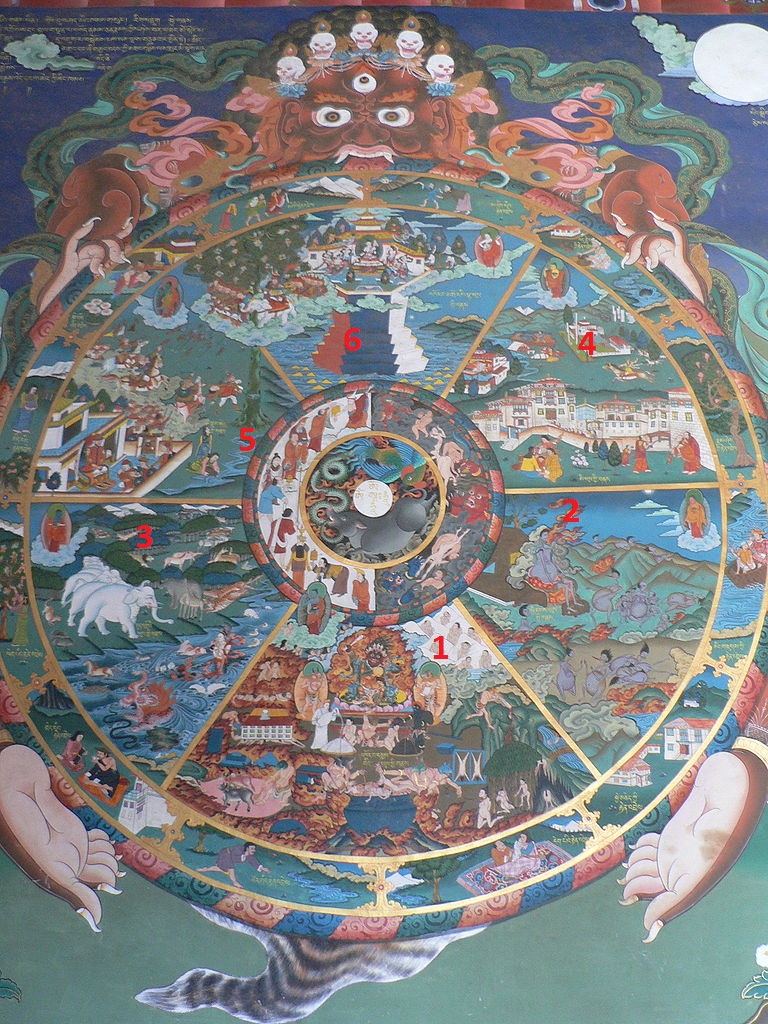3. De vigtigste doktriner 1. Karma og Samsara
Uddrag af ”Itivuttaka, The Group of Ones”
"Monks, I don't envision even one other fetter — fettered by which beings conjoined go wandering & transmigrating on for a long, long time — like the fetter of craving. Fettered with the fetter of craving, beings conjoined go wandering & transmigrating on for a long, long time."
Uddrag af ”Itivuttaka, The Group of Ones” (Iti 1-15), oversat fra pali af Thanissaro Bhikkhu. Access to Insight (Legacy Edition), 30. november 2013
http://www.accesstoinsight.org/tipitaka/kn/iti/iti.1.001-027.than.html
(oversættelse let bearbejdet)
Dette er et uddrag (§15) af Itivuttaka (“Som det blev sagt”) –sutraen, skrevet på pali, hvilket er en dialekt af sanskrit. Den er formentlig skrevet i det første århundrede f.v.t. En sutra er en hellig, buddhistisk tekst, der menes at indeholde Buddhas egne ord. Dette uddrag bekræfter, at mennesker er fanget i et cyklus af genfødsler (Samsara).
”Cula-kammavibhanga Sutta
Uddrag af ”Cula-kammavibhanga Sutta: The Shorter Exposition of Kamma”
Dette er et uddrag af begyndelsen af Cula-kammavibhanga (”Den korte redegørelse for Karma”) –sutraen, skrevet på pali, som er en dialekt af sanskrit. Den er formentlig skrevet i det første århundrede f.v.t. En sutra er en hellig, buddhistisk tekst, der menes at indeholde Buddhas egne ord. Dette uddrag forklarer gengældelsesmekanismen indeholdt i begrebet Karma.
- "1. Thus have I heard. On one occasion the Blessed One was living at Savatthi in Jeta's Grove, Anathapindika's Park. Then Subha the student, went to the Blessed One and exchanged greetings with him, and when the courteous and amiable talk was finished, he sat down at one side. When he had done so, Subha the student said to the Blessed One:
- 2. "Master Goutama, what is the reason, what is the condition, why inferiority and superiority are met with among human beings, among mankind? For one meets with short-lived and long-lived people, sick and healthy people, ugly and beautiful people, insignificant and influential people, poor and rich people, low-born and high-born people, stupid and wise people. What is the reason, what is the condition, why superiority and inferiority are met with among human beings, among mankind?"
- 3. "Student, beings are owners of karman, heirs of karman, they have karman as their progenitor, karman as their kin, karman as their homing-place. It is karman that differentiate beings according to inferiority and superiority."
- 4. "I do not understand the detailed meaning of Master Goutama's utterance spoken in brief without expounding the detailed meaning. It would be good if Master Goutama taught me the Dharma so that I might understand the detailed meaning of Master Goutama's utterance spoken in brief without expounding the detailed meaning."
"Then listen, student, and heed well what I shall say."
"Even so, Master Goutama," Subha the student replied. The Blessed One said this: - 5. "Here, student, some woman or man is a killer of living beings, murderous, bloody-handed, given to blows and violence, merciless to living beings. Due to having performed and completed such karman, on the dissolution of the body, after death, he reappears in a state of deprivation, in an unhappy destination, in perdition, in hell. If, on the dissolution of the body, after death, instead of his reappearing in a state of deprivation, in an unhappy destination, in perdition, in hell, he comes to the human state, he is short-lived wherever he is reborn. This is the way that leads to short life, that is to say, to be a killer of living beings, murderous, bloody-handed, given to blows and violence, merciless to living beings.
- 6. "But here some woman or man, having abandoned the killing of living beings, abstains from killing living beings, lays aside the rod and lays aside the knife, is considerate and merciful and dwells compassionate for the welfare of all living beings. Due to having performed and completed such Karman, on the dissolution of the body, after death, he reappears in a happy destination, in the heavenly world. If, on the dissolution of the body, after death, instead of his reappearing in a happy destination, in the heavenly world, he comes to the human state, he is long-lived wherever he is reborn. This is the way that leads to long life, that is to say, to have abandoned the killing of living beings, to abstain from killing living beings, to lay aside the rod and lay aside the knife, to be considerate and merciful, and to dwell compassionate for the welfare of all living beings".
Uddrag af ”Cula-kammavibhanga Sutta: The Shorter Exposition of Kamma” (MN 135), oversat fra pali af Ñanamoli Thera. Access to Insight (Legacy Edition), 30. november 2013
http://www.accesstoinsight.org/tipitaka/mn/mn.135.nymo.html
(oversættelse let bearbejdet)
Livshjulet

Billedet viser et Bhavacakra (”Livshjul”), som er en symbolsk fremstilling af Samsara. Dette eksempel findes på indersiden af Trongsa-fæstningens mur, grundlagt 1647 i Bhutan.
Fotografi af Stephen Shephard
CC-BY-SA-2.5






